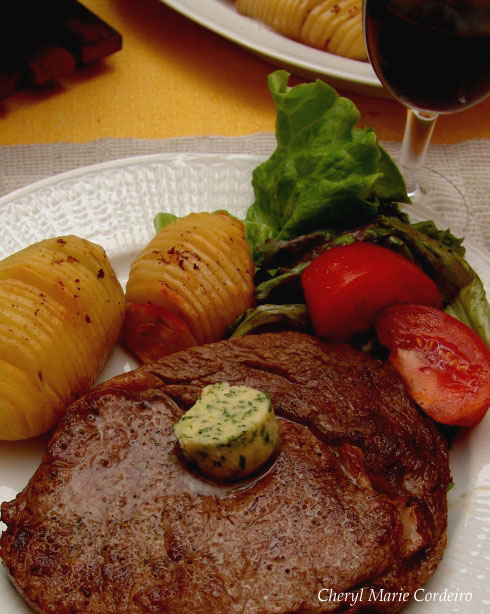
Entrecôte garnished with maïtre d’hôtel (butter creamed with chopped parsley, lemon juice, salt, and pepper). Salad with a light vinaigrette dressing and hasselback potatoes.
Photo for CMC by: Jan-Erik Nilsson © 2009.
Entrecôte with a Tuscan twist
The thing is, we really enjoyed our brief stay in Northern Italy and Florence last year and we miss it. After we came back home, we have been cooking things inspired by the region, we are enjoying the wines and some food we brought back and we make plans on places to see when we will be back. Rarely have we been so certain about going back to a place we have visited than to Tuscany. So when preparing an entrecôte dinner recently, it was nigh impossible not to put a Tuscan twist on the meal and for fun, we don’t mind sharing the recipe.
So here goes, Entrecôte alla Fiorentino.
The ideology behind Florentine cooking is basically to take great care when selecting the ingredients. The artist and genious Michelangelo came from Florence. If you have seen his Pieta in the St Peters Basilica in Rome, or his statue David in Florence, then you know what what a Florentine artist can make out of a slab of marble. Then imagine what a Florentine chef can do with a piece of meat! So, if we take Michelangelo’s and the Florentine spirit to our hearts and celebrate that in our own cooking, then wouldn’t we delight in the results?
In order of preparation
Bring out the meat from the fridge to let it warm up to room temperature. Each slice of meat should be about ½ pound or 250 gram. Sprinkle with freshly ground black pepper and non-iodine sea salt. The effect is that of a slight marinade and will improve flavour without impairing the quality of the fried meat.
A commentary on salt; Salt with iodine tastes artificial and adds a chemical touch to the food. Genuine Sea salt has an entirely different flavour, one that is almost sweet on the palate. Once you’ve tried proper salt you will never go back to industrial iodine added salt again. Though a bit pricey, soft crystal sea salt on the dining table is still one of the most inexpensive culinary delights you can indulge in. So go on, spoil yourself.
Potatoes
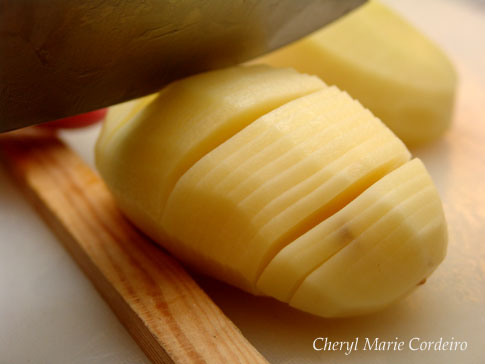
Slicing potatoes in the Hasselback style.
For a Tuscan inspired meat dish, you actually don’t need any side dishes besides a glass of wine I would say, but I’ll leave that to the specialists to decide. Personally being a friend of potatoes, here is how to make Hasselback potatoes. This variety got its name from the Swedish restaurant Hasselbacken in Stockholm who first came up with the idea of serving potatoes baked in this manner. The result is a crisp crust on the potatoes, with a moist and tender inside.
Peel potatoes and slice them from top to bottom but not fully through, so that they barely hang together and the slices remain upright standing. Heat the oven to around 200 centigrades, butter a deep tin with lard or oil. Top the potatoes with a thin slice of real butter to help in the browning and for a well-rounded taste.

A sliver of butter on top of each potato will add to the flavour and help the potatoes to bake

Hasselback style potatoes prepared and ready for the oven.

Throughout the baking process, open the oven every eight minutes and pour the potatoes with fat from the tin.
A crisp salad of lettuce, tomato and a balsamic vinaigrette
Choose sun ripened tomatoes and crisp lettuce. Discard any unripe tomatoes; leave them out if they don’t cut the grade. Most any fresh leafy greens will add nicely to the salad.
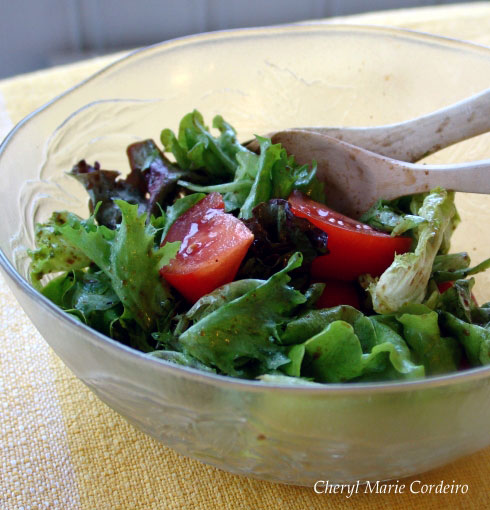
Salad with sun ripened tomatoes and a light vinaigrette dressing.
The vinaigrette
Prepare a vinaigrette and pour over the salad immediately before serving, toss lightly and add the tomatoes last. This vinaigrette for the salad is full bodied and not for the fickle hearted.
0.5 Tbsp really good balsamic vinegar
0.5 Tsp Honey
1 clove of garlic
1.5 Tbsp best possible extra virgin olive oil
Add black pepper and some sea salt to flavour.
For the vinaigrette, mix vinegar, honey and salt. Stir oil with a crushed garlic clove and pepper. Salt and honey mixes well with the vinegar. The oil is there to enhance the flavour of the spices – pepper and garlic – and to help the vinaigrette stick to the lettuce. The resulting 2 tbsp of vinaigrette is quite potent, so a little goes a long way.
A green pepper sauce with a dash of red wine

To crush all peppers in a motar is a really easy way of enhancing the flavour of most anything; here, the crushed black pepper that will be used for the steaks.
To make the sauce is maybe even more fun than frying the meat (or testing the wine). You can mix almost anything that adds zest to beef. You can add a dash of cognac to the frying pan when done and burn it off. You can melt a slize of gorgonzola or roquefort cheese and stir in with some sour creem or you can go crazy with a mix of peppers and some red wine. You can add tomato, parsley or garlic or honey fried almonds or mushrooms or … You can tweak the whole meal in any direction you like with the sauce! However, in keeping with Northern Italian cooking, I’d suggest an uncomplicated sauce based on pepper.
The following pepper sauce is one of my absolute favourites. It’s a sauce that can make or break a nice meat dinner for your guests on its merry self, if you fail to serve it.
Melt together equal parts butter and wheat flour. Stir-fry until golden brown on medium heat. Add some full cream, stir, and continue to add milk until you’re happy with the thickness. Add 1 tbsp green pepper, 1/2 tbsp rose pepper and a few dashes of black pepper. All freshly crushed. Add a dash of dark soy sauce, a dash of red wine and the beef broth from the frying pan when you are done. Sieve if necessary. Taste. Consider adding about half a beef meat cube, but be careful though, as they can be quite salty.
The beef
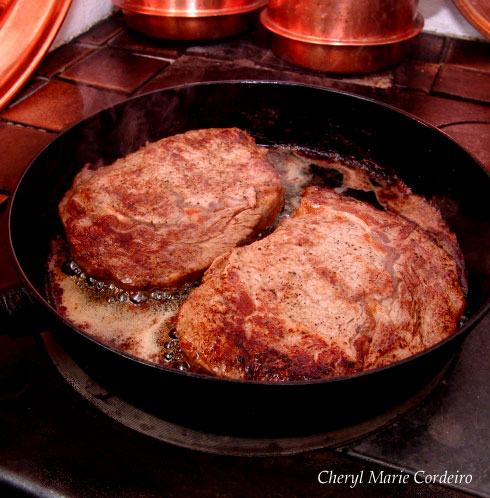
Entrecôte frying at medium heat in a cast iron pan, over a wood stove.
Add equal parts of butter and olive oil in a hot pan. If you like, fry one chopped up garlic in the fat, and discard when brown. Give the meat a quick frying on one side in the sizzling hot pan and turn it over. Now cook until ready on high heat slowly cooling off to medium.
To decide when the meat is done, see how soft it is by pressing on it with a fork. A chef would use his fingers for this delicate task.
Meat is usually considered better tasting when some of the proteins have solidified and the sugars in the meat juices have caramelized, but “done” is truly relative. First class beef you can eat raw, so that isn’t a real issue but a question of taste. Basically you need to learn how to feel when the meat is done to your own liking. “Soft and Spongy” means raw. “Some stiffness”, means medium rare. When the steak is starting to shrink, that means well done. “Hard and not spongy at all”, means that the steak is dead.
When you’re done frying, give the meat a few minutes to rest. Take your time, taste the wine, and then serve. Some parsley-flavoured butter – maïtre d’hôtel – might fit nicely to the dish.
The wine to the dine
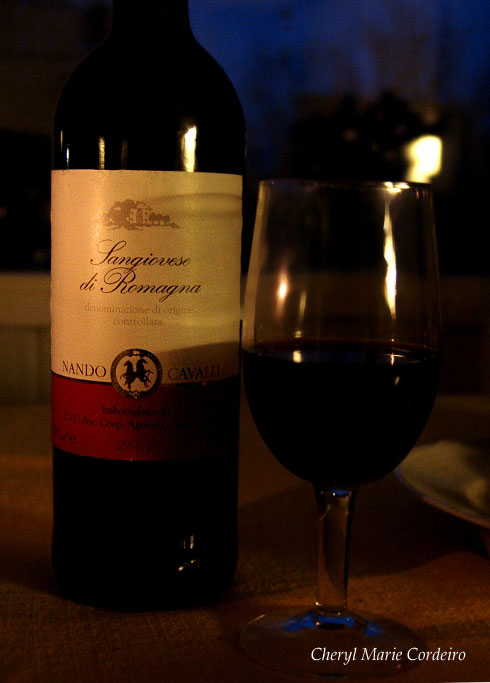
A bottle of Sangiovese di Romagna 2007, to accompany the meal.
The drink selection is very personal. This meal in general is full-bodied and strongly flavoured, so any wine fittingly ‘macho’ in personality will do fine.
Our choice would be one a Sangiovese di Romagna 2007, that we brought back a case of from San Gimignano. This is one of the most traditional Italian table wines possible and one that happened to suit the day, our mood and this meal perfectly when we tried this last.
Kyle Phillips, who lives in Tuscany and writes for the Italian Wine Review has written a splendid article on wines from this area.
As the recipe indicates, whatever drink chosen to accompany this meal will need some attitude, or the food will walk all over it.
Enjoy!